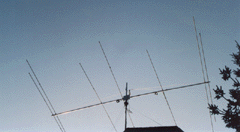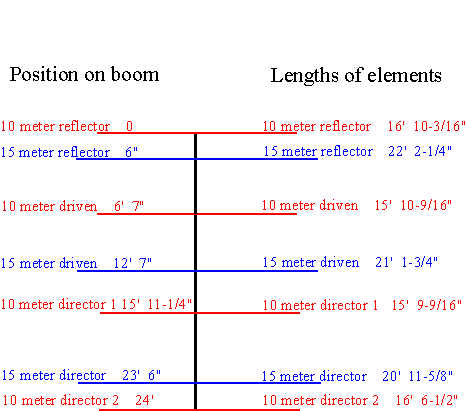The HF Satellite Antenna
Here is an antenna for the nineties. It's strong, computer designed, and has lots of gain.


This is a no compromise dual band antenna. Instead of using traps, this design interlaces two separate antennas (the 10 meter band and the 15 meter band) on one
boom. This is a full size, four element beam on 10, and three elements on 15 meters!
The design uses large 1" diameter aluminum tubing to keep ohmic losses to a minimum, to survive heavy winds and withstand ice buildups in the winter.
The fact that it is both a 10 and 15 meter antenna allows it to be used as the perfect antenna for anyone interested in working the RS Satellites which have uplinks
on 15 and downlinks on the 10 meter band.
The HF-SAT produces plenty of gain on both bands. The antenna was computer optimized for maximum forward gain (hence the low front to back). The 10 meter
band has close to 9 dBd gain, (free space) and the 15 meter band produces over 7 dBd (also free space).
Construction:
Since all elements are of 1" tubing, it's just a matter of laying out each element end to end and cutting the last piece to the required length for that element. Each 1"
section is joined to the next piece via a third piece of aluminum (.875 inch diameter) which slides into the 1" sections (See figure 1). Drill holes on either side of the
joint and use bolts to secure each section in place. Attachment of the elements to the boom is achieved by the use of muffler clamps.

Feeding:
Current baluns should be used at each feed point and can be either commercial models or just loop several turns of the cable to create your own balun. Separate
cables are run to each feed point and then run to a mast mounted switch box or straight into the shack. You can choose you own favorite matching method but in
this case a gamma match was used at each feed point, and this worked well. If the antenna is mounted at 40 feet, the 10 meter antenna should have an impedance
near 13 ohms. The 15 meter antenna is around 27 ohms. If you'd like, you could just use a 50 to 25 ohm balun to match the 15 meter antenna, and skip the gamma
match here.
Gain:
| 10 Meters
| 10 Meters
| 15 Meters
| 15 Meters
|
| Free space
| Over ground
| Free space
| Over ground
|
| Gain
| 8.92 dBd
| 13.82 dBd
| 7.36 dBd
| 12.22 dBd
|
| F/B
| 12.47 dB
| 12.08 dB
| 7.13 dB
| 6.86 dB
|
| Impedance
| 13.1 + j 2.1
| 12.8 + j 1.4
| 27.4 + j 1.5
| 27.0 + j 1.3
|
Test out:
The initial tests of this antenna were performed while on a 10 foot pole. The comparison antenna was a 3 element, 10 meter mono-bander created using standard
beam formulas and was not computer designed. Local tests showed that the HF-SAT antenna was already slightly better signal wise than the 40 foot high 3 element
beam. Once the HF-SAT antenna was taken up to the 40 foot height it proved to be 10 dB stronger than the original causally designed antenna, an impressive and
worthwhile increase in gain, to say the least. The antenna has been excellent on both bands.
Antenna Construction Tips
Back to the Antenna Elmer
Back to the Home Page





